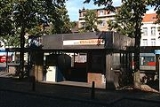
Saint Catherine metro station
Encyclopedia
Sainte Catherine/Sint Katelijne is a Brussels metro
station in the City of Brussels
, Belgium
. It is located between the "Quai aux Briques/Baksteenkaai" and the "Quai du Bois à Brûler/Brandhoutkaai," near the church of St. Catherine, which gives the station its name. The station was inaugurated when the first Brussels Metro line was converted from "premetro" (operated with trams) to "heavy" metro
. It is currently served by lines 1A and 1B, which use the same tracks at this point.
The station was opened on 13 April 1977 - a short extension from the neighbouring De Brouckère station. Until 1981 (with the opening of the extension to Beekkant), the station was the western terminus of the Metro.
The station is unique in Brussels for being located in the reclaimed and covered space of an old harbor dock
. Because of this, the metro tunnel runs very shallow at this point, making the station one of the few in Brussels that lack an underground mezzanine. Entrances and exits from the station lead up into the middle of the Sainte Catherine square.
Because of the proximity of the foundations of St. Catherine's church and the old city wall, the line immediately to the east of the station has the sharpest curve on the entire Brussels Metro system and is subject to a severe speed restriction.
In late 2006 and in 2007, the underground station underwent a thorough renovation giving it a more modern look both under and above ground.
Brussels Metro
The Brussels Metro is a rapid transit system serving a large part of the Brussels-Capital Region of Belgium. It consists of a network with four metro line services with some shared sections. The metro has 49.9 km of network and 59 stations...
station in the City of Brussels
City of Brussels
The City of Brussels is the largest municipality of the Brussels-Capital Region, and the official capital of Belgium by law....
, Belgium
Belgium
Belgium , officially the Kingdom of Belgium, is a federal state in Western Europe. It is a founding member of the European Union and hosts the EU's headquarters, and those of several other major international organisations such as NATO.Belgium is also a member of, or affiliated to, many...
. It is located between the "Quai aux Briques/Baksteenkaai" and the "Quai du Bois à Brûler/Brandhoutkaai," near the church of St. Catherine, which gives the station its name. The station was inaugurated when the first Brussels Metro line was converted from "premetro" (operated with trams) to "heavy" metro
Rapid transit
A rapid transit, underground, subway, elevated railway, metro or metropolitan railway system is an electric passenger railway in an urban area with a high capacity and frequency, and grade separation from other traffic. Rapid transit systems are typically located either in underground tunnels or on...
. It is currently served by lines 1A and 1B, which use the same tracks at this point.
The station was opened on 13 April 1977 - a short extension from the neighbouring De Brouckère station. Until 1981 (with the opening of the extension to Beekkant), the station was the western terminus of the Metro.
The station is unique in Brussels for being located in the reclaimed and covered space of an old harbor dock
Dock (maritime)
A dock is a human-made structure or group of structures involved in the handling of boats or ships, usually on or close to a shore.However, the exact meaning varies among different variants of the English language...
. Because of this, the metro tunnel runs very shallow at this point, making the station one of the few in Brussels that lack an underground mezzanine. Entrances and exits from the station lead up into the middle of the Sainte Catherine square.
Because of the proximity of the foundations of St. Catherine's church and the old city wall, the line immediately to the east of the station has the sharpest curve on the entire Brussels Metro system and is subject to a severe speed restriction.
In late 2006 and in 2007, the underground station underwent a thorough renovation giving it a more modern look both under and above ground.

